Aerosol Optical and Microphysical Properties of Four Typical Sites of SONET in China Based on Remote Sensing Measurements
Abstract
:1. Introduction
2. SONET and Observation Sites
2.1. Sun-Sky Radiometer Observation Network
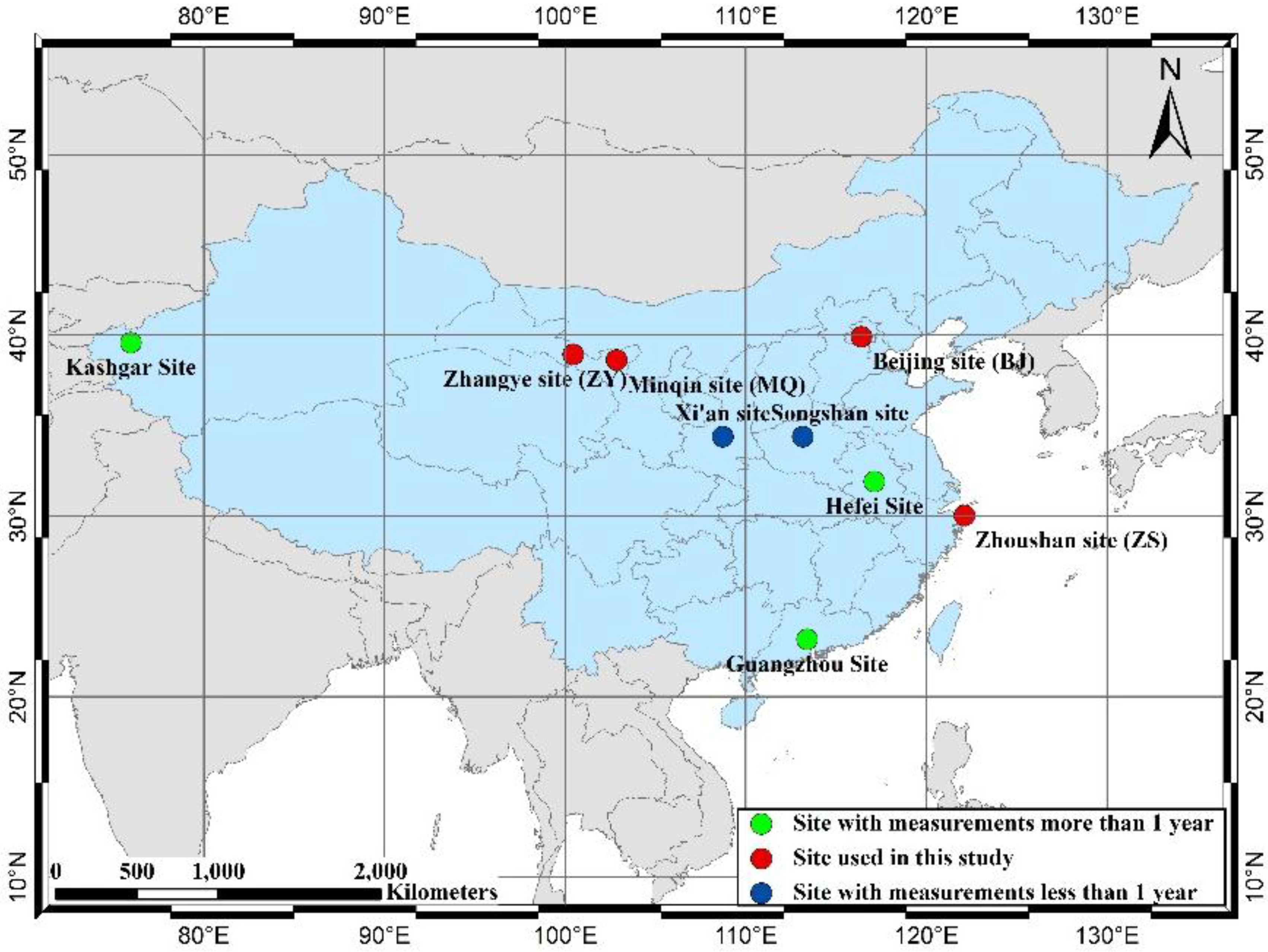
2.2. Observation Sites and Data
| Site Observation Period | Season | N. of Aerosol Optical Depth | N. of Retrievals (Size Distribution) | N. of Retrievals (Other Parameters) |
|---|---|---|---|---|
| Beijing (BJ) March 2012–February 2013 | Spring | 284 | 215 | 128 |
| Summer | 212 | 103 | 56 | |
| Autumn | 396 | 232 | 144 | |
| Winter | 374 | 204 | 102 | |
| Zhangye (ZY) March 2013–February 2014 | Spring | 407 | 127 | 53 |
| Summer | 424 | 99 | 26 | |
| Autumn | 330 | 295 | 75 | |
| Winter | 155 | 87 | 39 | |
| Minqin (MQ) March 2012–February 2013 | Spring | 323 | 100 | 73 |
| Summer | 311 | 104 | 53 | |
| Autumn | 404 | 186 | 64 | |
| Winter | 137 | 85 | 7 | |
| Zhoushan (ZS) March 2012–February 2013 | Spring | 460 | 206 | 180 |
| Summer | 278 | 88 | 46 | |
| Autumn | 335 | 232 | 144 | |
| Winter | 282 | 150 | 135 |
3. Methodology
3.1. Calibration of Sun-Sky Radiometer
3.2. Inversion of Aerosol Properties
| Aerosol Parameters | Uncertainties | |
|---|---|---|
| Refractive index | Real part n | 0.04 (0.025–0.05) |
| Imaginary part k | 40% (30%–100%) | |
| Size distribution | 0.1 μm < r < 7 μm | 25% (15%–35%) |
| r > 7 μm & r < 0.1 μm | 50% (15%–100%) | |
| SSA | 0.03 (0.03~0.07) | |
| AOD | 0.01–0.02 | |
4. Results and Discussion
4.1. Aerosol Optical Depth
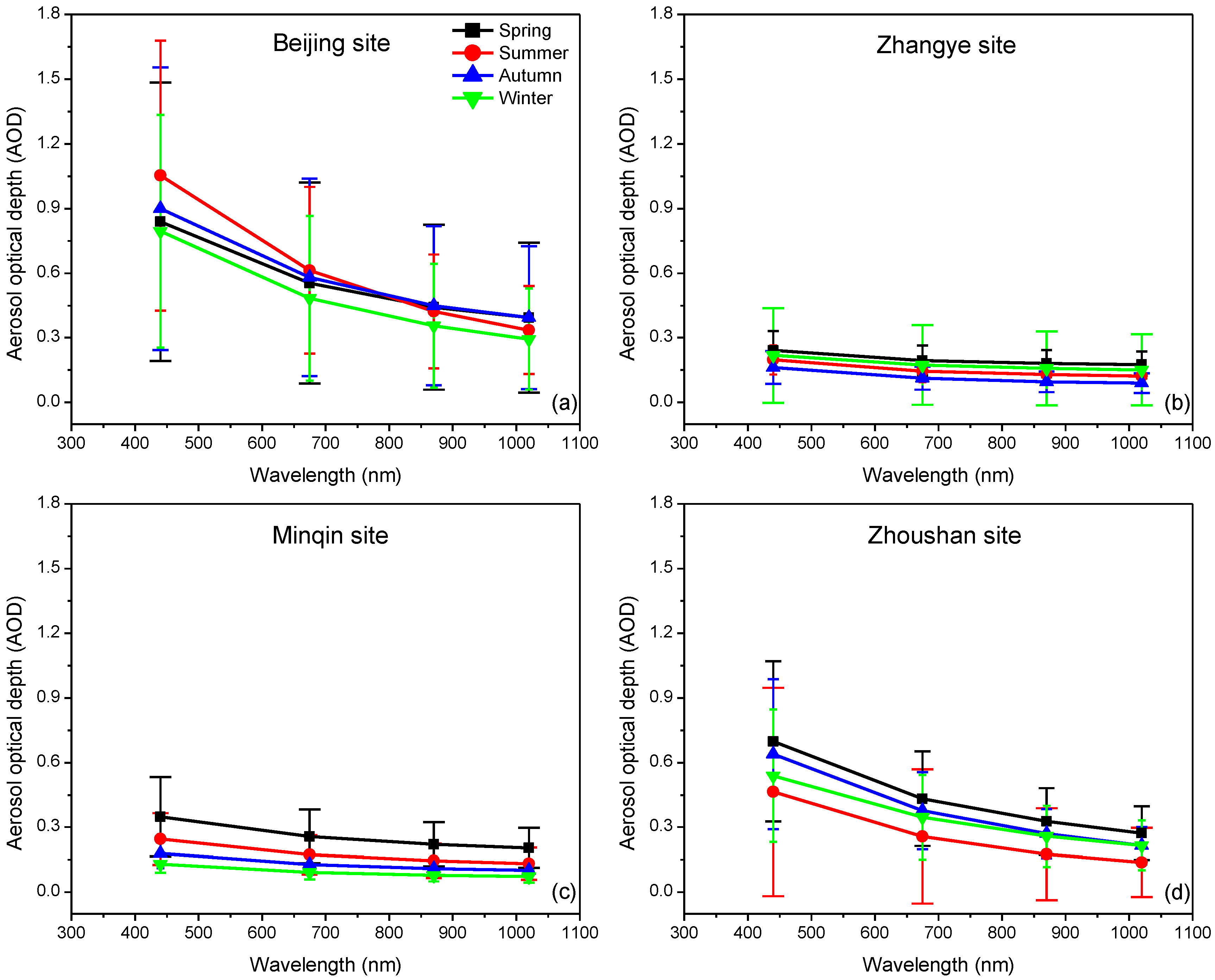
| Site | Season | AODf (440 nm) | FMF (440 nm) |
|---|---|---|---|
| BJ | Spring | 0.63 ± 0.57 | 0.75 |
| Summer | 0.98 ± 0.62 | 0.93 | |
| Autumn | 0.71 ± 0.61 | 0.79 | |
| Winter | 0.73 ± 0.53 | 0.91 | |
| ZY | Spring | 0.12 ± 0.06 | 0.48 |
| Summer | 0.11 ± 0.05 | 0.57 | |
| Autumn | 0.10 ± 0.05 | 0.63 | |
| Winter | 0.11 ± 0.11 | 0.52 | |
| MQ | Spring | 0.22 ± 0.16 | 0.64 |
| Summer | 0.17 ± 0.09 | 0.68 | |
| Autumn | 0.12 ± 0.06 | 0.64 | |
| Winter | 0.13 ± 0.07 | 0.58 | |
| ZS | Spring | 0.58 ± 0.36 | 0.82 |
| Summer | 0.43 ± 0.48 | 0.92 | |
| Autumn | 0.57 ± 0.35 | 0.89 | |
| Winter | 0.49 ± 0.31 | 0.91 |
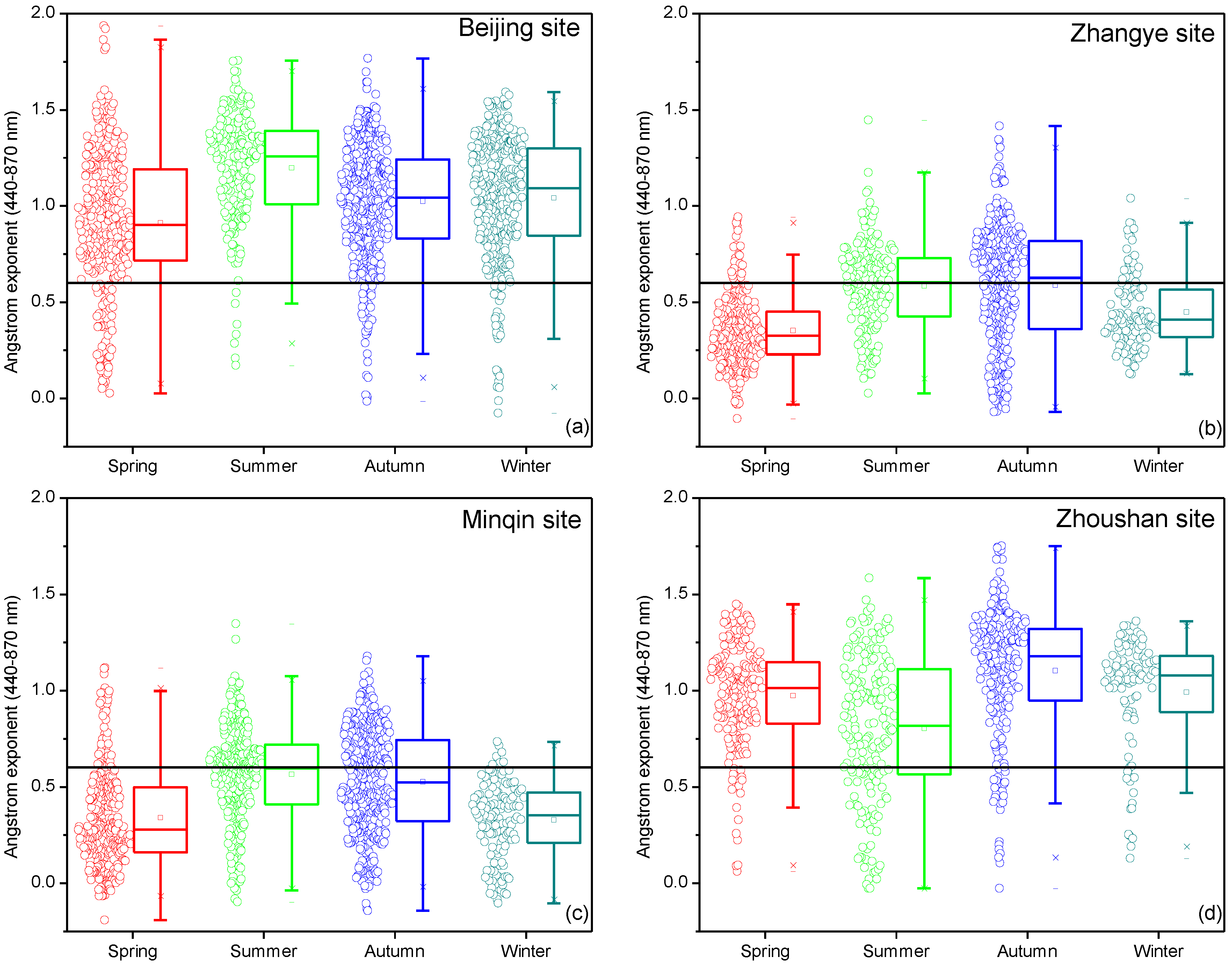
4.2. Ångström Exponent
4.3. Volume Size Distribution

| Site | Season | Total Volume Concentration (μm3/μm2) | VFMF |
|---|---|---|---|
| BJ | Spring | 0.36 ± 0.30 | 0.26 ± 0.15 |
| Summer | 0.26 ± 0.12 | 0.51 ± 0.20 | |
| Autumn | 0.25 ± 0.14 | 0.38 ± 0.17 | |
| Winter | 0.20 ± 0.11 | 0.49 ± 0.14 | |
| ZY | Spring | 0.15 ± 0.06 | 0.07 ± 0.03 |
| Summer | 0.10 ± 0.04 | 0.14 ± 0.09 | |
| Autumn | 0.08 ± 0.04 | 0.17 ± 0.09 | |
| Winter | 0.13 ± 0.12 | 0.07 ± 0.02 | |
| MQ | Spring | 0.16 ± 0.08 | 0.18 ± 0.12 |
| Summer | 0.11 ± 0.07 | 0.21 ± 0.12 | |
| Autumn | 0.09 ± 0.04 | 0.18 ± 0.11 | |
| Winter | 0.11 ± 0.09 | 0.12 ± 0.07 | |
| ZS | Spring | 0.21 ± 0.09 | 0.39 ± 0.14 |
| Summer | 0.13 ± 0.09 | 0.55 ± 0.14 | |
| Autumn | 0.17 ± 0.07 | 0.50 ± 0.19 | |
| Winter | 0.14 ± 0.06 | 0.45 ± 0.17 |
4.4. Aerosol Complex Refractive Index

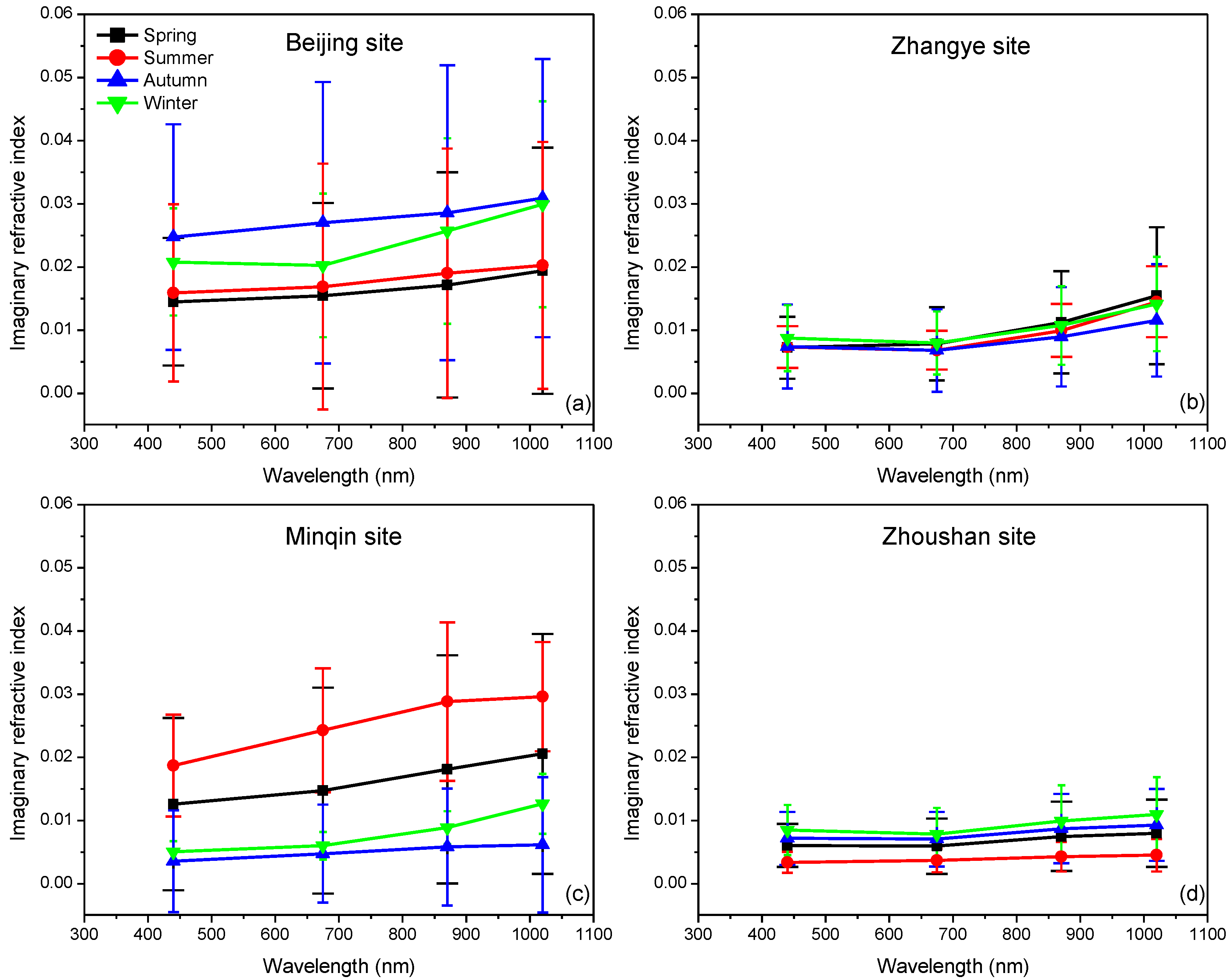
4.5. Single Scattering Albedo
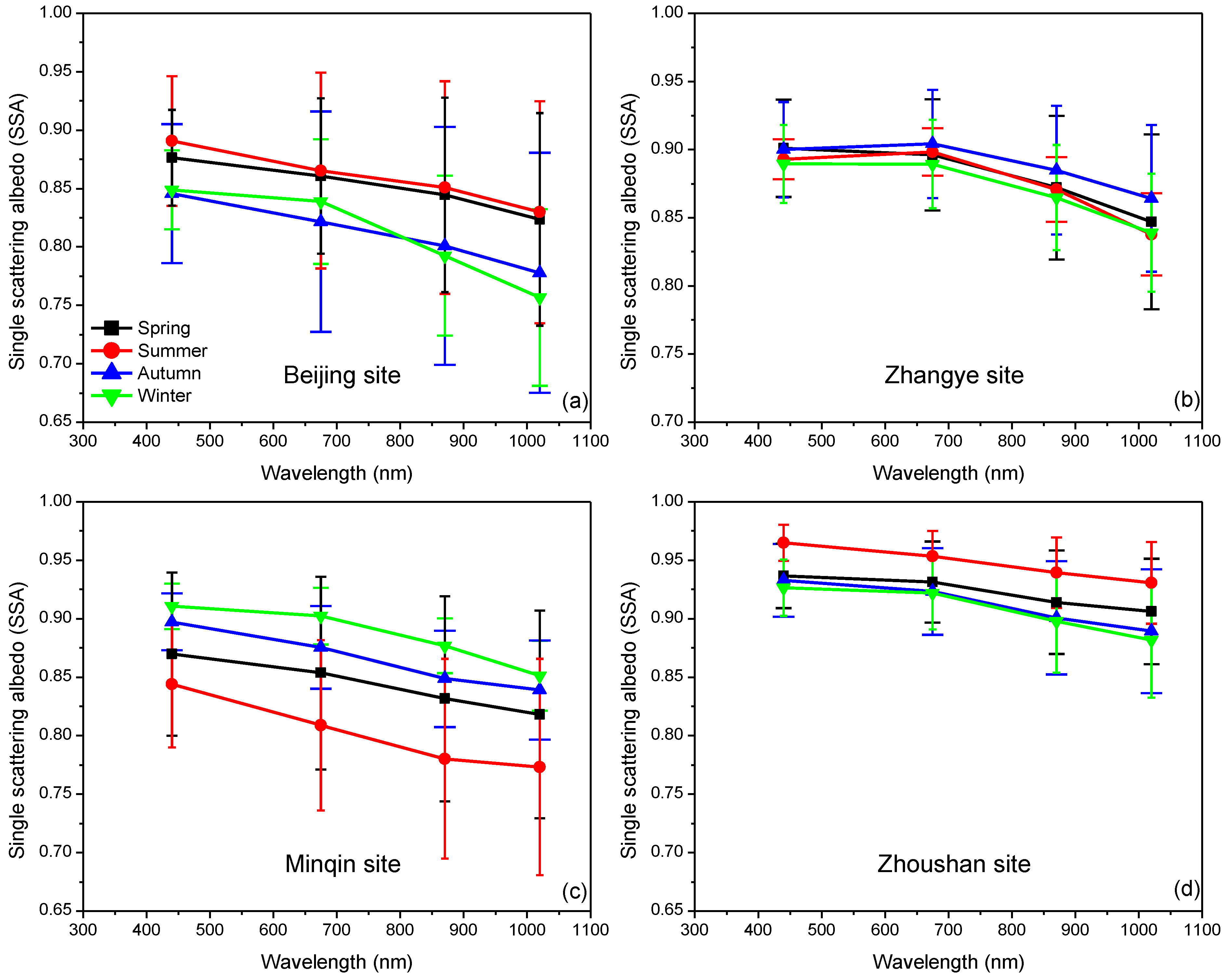
4.6. Percentage of Spherical Particles
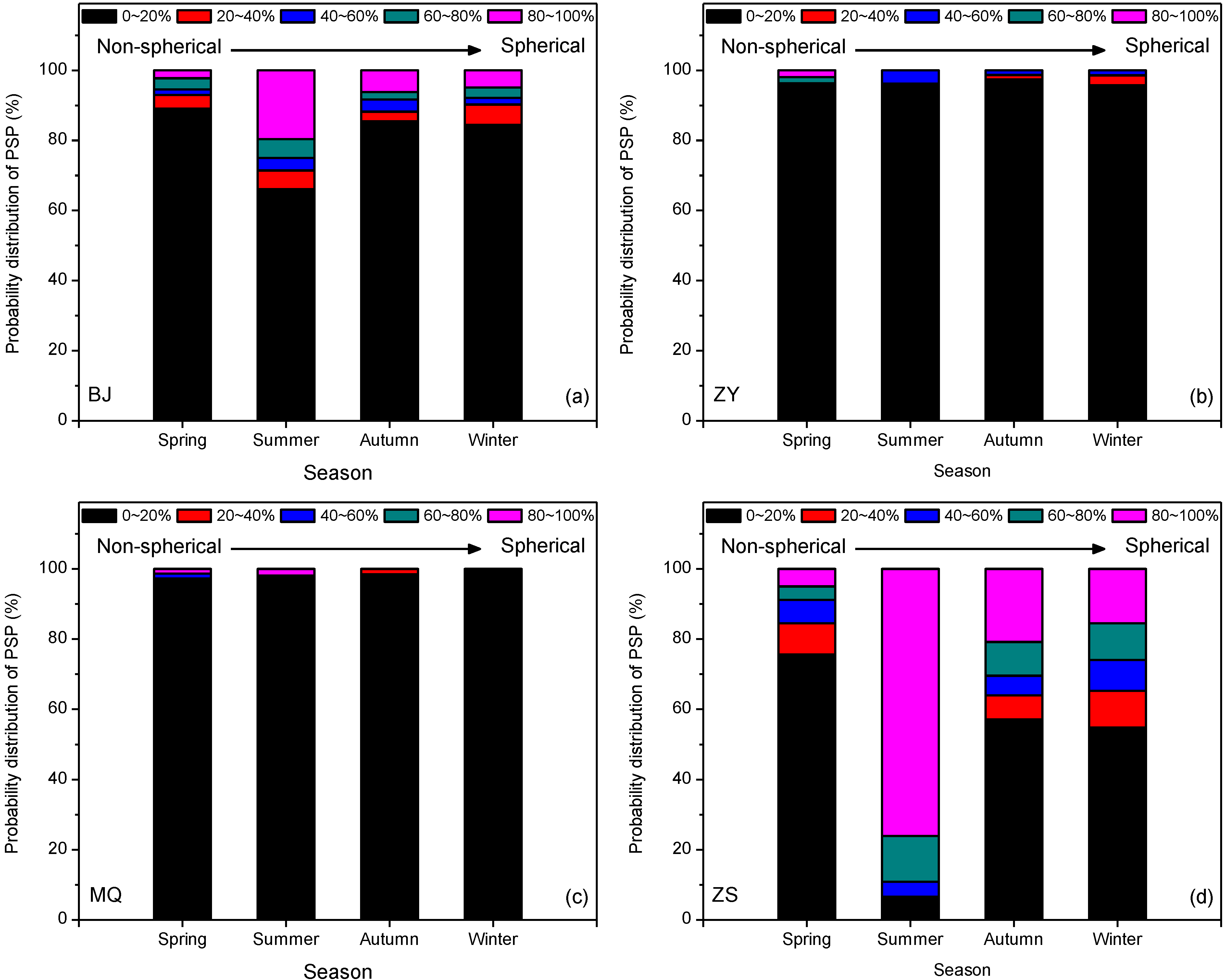
5. Conclusions
Acknowledgments
Author Contributions
Conflicts of Interest
References
- Haywood, J.; Boucher, O. Estimates of the direct and indirect radiative forcing due to tropospheric aerosols: A review. Rev. Geophys. 2000, 38, 513–543. [Google Scholar]
- Haywood, J.M.; Shine, K.P. The effect of anthropogenic sulfate and soot aerosol on the clear-sky planetary radiation budget. Geophys. Res. Lett. 1995, 22, 603–606. [Google Scholar]
- Lee, J.; Kim, J.; Song, C.H.; Kim, S.B.; Chun, Y.; Sohn, B.J.; Holben, B.N. Characteristics of aerosol types from AERONET sunphotometer measurements. Atmos. Environ. 2010, 44, 3110–3117. [Google Scholar]
- Eck, T.F.; Holben, B.N.; Dubovik, O.; Smirnov, A.; Goloub, P.; Chen, H.B.; Chatenet, B.; Gomes, L.; Zhang, X.Y.; Tsay, S.C.; et al. Columnar aerosol optical properties at AERONET sites in Central Eastern Asia and aerosol transport to the tropical mid-Pacific. J. Geophys. Res. Atmos. 2005. [Google Scholar] [CrossRef]
- He, X.; Li, C.C.; Lau, A.K.H.; Deng, Z.Z.; Mao, J.T.; Wang, M.H.; Liu, X.Y. An intensive study of aerosol optical properties in Beijing urban area. Atmos. Chem. Phys. 2009, 9, 8903–8915. [Google Scholar]
- Van Beelen, A.J.; Roelofs, G.J.H.; Hasekamp, O.P.; Henzing, J.S.; Rockmann, T. Estimation of aerosol water and chemical composition from AERONET sun-sky radiometer measurements at Cabauw, the Netherlands. Atmos. Chem. Phys. 2014, 14, 5969–5987. [Google Scholar] [CrossRef]
- Liu, P.F.; Zhao, C.S.; Zhang, Q.; Deng, Z.Z.; Huang, M.Y.; Ma, X.C.; Tie, X.X. Aircraft study of aerosol vertical distributions over Beijing and their optical properties. Tellus B 2009, 61, 756–767. [Google Scholar]
- Ma, N.; Zhao, C.S.; Nowak, A.; Muller, T.; Pfeifer, S.; Cheng, Y.F.; Deng, Z.Z.; Liu, P.F.; Xu, W.Y.; Ran, L.; et al. Aerosol optical properties in the north China plain during Hachi campaign: An in-situ optical closure study. Atmos. Chem. Phys. 2011, 11, 5959–5973. [Google Scholar]
- Omar, A.H.; Won, J.G.; Winker, D.M.; Yoon, S.C.; Dubovik, O.; McCormick, M.P. Development of global aerosol models using cluster analysis of Aerosol Robotic Network (AERONET) measurements. J. Geophys. Res. Atmos. 2005, 110. [Google Scholar] [CrossRef]
- Li, Z.; Gu, X.; Wang, L.; Li, D.; Xie, Y.; Li, K.; Dubovik, O.; Schuster, G.; Goloub, P.; Zhang, Y.; et al. Aerosol physical and chemical properties retrieved from ground-based remote sensing measurements during heavy haze days in Beijing winter. Atmos. Chem. Phys. 2013, 13, 10171–10183. [Google Scholar] [Green Version]
- Che, H.; Xia, X.; Zhu, J.; Li, Z.; Dubovik, O.; Holben, B.; Goloub, P.; Chen, H.; Estelles, V.; Cuevas-Agullo, E.; et al. Column aerosol optical properties and aerosol radiative forcing during a serious haze-fog month over north China plain in 2013 based on ground-based sunphotometer measurements. Atmos. Chem. Phys. 2014, 14, 2125–2138. [Google Scholar]
- Lewis, K.; Arnott, W.P.; Moosmuller, H.; Wold, C.E. Strong spectral variation of biomass smoke light absorption and single scattering albedo observed with a novel dual-wavelength photoacoustic instrument. J. Geophys. Res. Atmos. 2008, 113, D16203. [Google Scholar]
- Kirchstetter, T.W.; Novakov, T.; Hobbs, P.V. Evidence that the spectral dependence of light absorption by aerosols is affected by organic carbon. J. Geophys. Res. Atmos. 2004. [Google Scholar] [CrossRef]
- Xie, Y.S.; Li, Z.Q.; Li, L.; Wang, L.; Li, D.H.; Chen, C.; Li, K.T.; Xu, H. Study on influence of different mixing rules on the aerosol components retrieval from ground-based remote sensing measurements. Atmos. Res. 2014, 145, 267–278. [Google Scholar]
- Kokhanovsky, A.A.; von Hoyningen-Huene, W.; Burrows, J.P. Atmospheric aerosol load as derived from space. Atmos. Res. 2006, 81, 176–185. [Google Scholar]
- Park, R.S.; Song, C.H.; Han, K.M.; Park, M.E.; Lee, S.S.; Kim, S.B.; Shimizu, A. A study on the aerosol optical properties over East Asia using a combination of CMAQ-simulated aerosol optical properties and remote-sensing data via a data assimilation technique. Atmos. Chem. Phys. 2011, 11, 12275–12296. [Google Scholar]
- Li, J.; Carlson, B.E.; Dubovik, O.; Lacis, A.A. Recent trends in aerosol optical properties derived from AERONET measurements. Atmos. Chem. Phys. 2014, 14, 12271–12289. [Google Scholar]
- Eck, T.F.; Holben, B.N.; Sinyuk, A.; Pinker, R.T.; Goloub, P.; Chen, H.; Chatenet, B.; Li, Z.; Singh, R.P.; Tripathi, S.N.; et al. Climatological aspects of the optical properties of fine/coarse mode aerosol mixtures. J. Geophys. Res. Atmos. 2010. [CrossRef]
- Liu, Q.; Hong, Y.L. Comparison of aerosol single scattering albedo derived from the Ozone Monitoring Instrument with aerosol robotic network observations. Atmos. Ocean. Sci. Lett. 2012, 5, 264–269. [Google Scholar]
- Dubovik, O.; Holben, B.; Eck, T.F.; Smirnov, A.; Kaufman, Y.J.; King, M.D.; Tanre, D.; Slutsker, I. Variability of absorption and optical properties of key aerosol types observed in worldwide locations. J. Atmos. Sci. 2002, 59, 590–608. [Google Scholar]
- Che, H.; Shi, G.; Uchiyama, A.; Yamazaki, A.; Chen, H.; Goloub, P.; Zhang, X. Intercomparison between aerosol optical properties by a prede skyradiometer and cimel sunphotometer over Beijing, China. Atmos. Chem. Phys. 2008, 8, 3199–3214. [Google Scholar]
- Smirnov, A.; Holben, B.N.; Dubovik, O.; Frouin, R.; Eck, T.F.; Slutsker, I. Maritime component in aerosol optical models derived from aerosol robotic network data. J. Geophys. Res. Atmos. 2003. [Google Scholar] [CrossRef]
- Li, Z.Q.; Goloub, P.; Devaux, C.; Gu, X.F.; Deuze, J.L.; Qiao, Y.L.; Zhao, F.S. Retrieval of aerosol optical and physical properties from ground-based spectral, multi-angular, and polarized sun-photometer measurements. Remote Sens. Environ. 2006, 101, 519–533. [Google Scholar]
- Holben, B.N.; Eck, T.F.; Slutsker, I.; Tanre, D.; Buis, J.P.; Setzer, A.; Vermote, E.; Reagan, J.A.; Kaufman, Y.J.; Nakajima, T.; et al. AERONET—A federated instrument network and data archive for aerosol characterization. Remote Sens. Environ. 1998, 66, 1–16. [Google Scholar]
- Toledano, C.; Cachorro, V.E.; Gausa, M.; Stebel, K.; Aaltonen, V.; Berjon, A.; de Galisteo, J.P.O.; de Frutos, A.M.; Bennouna, Y.; Blindheim, S.; et al. Overview of sun photometer measurements of aerosol properties in Scandinavia and Svalbard. Atmos. Environ. 2012, 52, 18–28. [Google Scholar] [Green Version]
- Holben, B.N.; Tanre, D.; Smirnov, A.; Eck, T.F.; Slutsker, I.; Abuhassan, N.; Newcomb, W.W.; Schafer, J.S.; Chatenet, B.; Lavenu, F.; et al. An emerging ground-based aerosol climatology: Aerosol optical depth from AERONET. J. Geophys. Res. Atmos. 2001, 106, 12067–12097. [Google Scholar]
- Nakajima, T.; Sekiguchi, M.; Takemura, T.; Uno, I.; Higurashi, A.; Kim, D.; Sohn, B.J.; Oh, S.N.; Nakajima, T.Y.; Ohta, S.; et al. Significance of direct and indirect radiative forcings of aerosols in the East China sea region. J. Geophys. Res. Atmos. 2003. [Google Scholar] [CrossRef]
- Goloub, P.; Li, Z.; Dubovik, O.; Blarel, L.; Podvin, T.; Jankowiak, I.; Lecoq, R.; Lecoq, R.; Deroo, C.; Chatenet, B.; et al. Photons/AERONET sunphotometer network overview. Description-activities-results-art. Proc. SPIE 2008. [Google Scholar] [CrossRef]
- Bokoye, A.I.; Royer, A.; O’Neill, N.T.; Cliche, P.; Fedosejevs, G.; Teillet, P.M.; McArthur, L.J.B. Characterization of atmospheric aerosols across Canada from a ground-based sunphotometer network: Aerocan. Atmos. Ocean 2001, 39, 429–456. [Google Scholar]
- Che, H.Z.; Zhang, X.Y.; Chen, H.B.; Damiri, B.; Goloub, P.; Li, Z.Q.; Zhang, X.C.; Wei, Y.; Zhou, H.G.; Dong, F.; et al. Instrument calibration and aerosol optical depth validation of the China aerosol remote sensing network. J. Geophys. Res. Atmos. 2009. [Google Scholar] [CrossRef]
- Xin, J.Y.; Wang, Y.S.; Li, Z.Q.; Wang, P.C.; Hao, W.M.; Nordgren, B.L.; Wang, S.G.; Liu, G.R.; Wang, L.L.; Wen, T.X.; et al. Aerosol optical depth (AOD) and angstrom exponent of aerosols observed by the Chinese Sun Hazemeter Network from August 2004 to September 2005. J. Geophys. Res. Atmos. 2007. [Google Scholar] [CrossRef]
- Garland, R.M.; Yang, H.; Schmid, O.; Rose, D.; Nowak, A.; Achtert, P.; Wiedensohler, A.; Takegawa, N.; Kita, K.; Miyazaki, Y.; et al. Aerosol optical properties in a rural environment near the mega-city Guangzhou, China: Implications for regional air pollution, radiative forcing and remote sensing. Atmos. Chem. Phys. 2008, 8, 5161–5186. [Google Scholar]
- Yan, P.; Tang, J.; Huang, J.; Mao, J.T.; Zhou, X.J.; Liu, Q.; Wang, Z.F.; Zhou, H.G. The measurement of aerosol optical properties at a rural site in Northern China. Atmos. Chem. Phys. 2008, 8, 2229–2242. [Google Scholar]
- Li, Z.Q.; Eck, T.; Zhang, Y.; Zhang, Y.H.; Li, D.H.; Li, L.; Xu, H.; Hou, W.Z.; Lv, Y.; Goloub, P.; et al. Observations of residual submicron fine aerosol particles related to cloud and fog processing during a major pollution event in Beijing. Atmos. Environ. 2014, 86, 187–192. [Google Scholar]
- Chen, H.; Gu, X.; Cheng, T.; Li, Z.; Yu, T. The spatial-temporal variations in optical properties of atmosphere aerosols derived from AERONET dataset over China. Meteorol. Atmos. Phys. 2013, 122, 65–73. [Google Scholar]
- Xu, H.; Li, Z.Q.; Li, D.H.; Li, L.; Chen, X.F.; Xie, Y.S.; Li, K.T.; Chen, C.; Zhang, Y.H. Ground-based polarimetric remote sensing of dust aerosol properties in Chinese deserts near Hexi Corridor. Adv. Meteorol. 2014, 2014, 240452. [Google Scholar]
- Xie, Y.S.; Li, D.H.; Li, K.T.; Zhang, L.; Chen, C.; Xu, H.; Li, Z.Q. Aerosol optical and microphysical properties in haze days based on ground-based remote sensing measurements. J. Remote Sens. 2013, 17, 970–980. [Google Scholar]
- Min, M.; Wang, P.C.; Zong, X.M.; Xia, J.R.; Meng, X.Y. Observation and study on aerosol properties in hazy days. Clim. Environ. Res. 2009, 14, 153–160. [Google Scholar]
- Yu, X.N.; Li, X.M.; Deng, Z.R.D.; de, Q.Y.Z.; Yuan, S. Optical properties of aerosol during haze-fog episodes in Beijing. Environ. Sci. 2012, 33, 1057–1062. [Google Scholar]
- Xia, X.; Chen, H.; Goloub, P.; Zhang, W.; Chatenet, B.; Wang, P. A compilation of aerosol optical properties and calculation of direct radiative forcing over an urban region in Northern China. J. Geophys. Res. Atmos. 2007. [Google Scholar] [CrossRef]
- Liu, Y.; Huang, J.; Shi, G.; Takamura, T.; Khatri, P.; Bi, J.; Shi, J.; Wang, T.; Wang, X.; Zhang, B. Aerosol optical properties and radiative effect determined from sky-radiometer over loess Plateau of Northwest China. Atmos. Chem. Phys. 2011, 11, 11455–11463. [Google Scholar]
- Smirnov, A.; Holben, B.N.; Kaufman, Y.J.; Dubovik, O.; Eck, T.F.; Slutsker, I.; Pietras, C.; Halthore, R.N. Optical properties of atmospheric aerosol in maritime environments. J. Atmos. Sci. 2002, 59, 501–523. [Google Scholar]
- Li, Z.Q.; Li, D.H.; Li, K.T.; Xu, H.; Chen, X.F.; Chen, C.; Xie, Y.S.; Li, L.; Li, L.; Li, W.; et al. Sun-sky radiometer observation network with the extension of multi-wavelength polarization measurements. J. Remote Sens. 2015, 19, 495–519. [Google Scholar]
- Li, Z.Q.; Blarel, L.; Podvin, T.; Goloub, P.; Buis, J.P.; Morel, J.P. Transferring the calibration of direct solar irradiance to diffuse-sky radiance measurements for CIMEL sun-sky radiometers. Appl. Opt. 2008, 47, 1368–1377. [Google Scholar]
- Li, Z.Q.; Goloub, P.; Blarel, L.; Yang, B.Y.; Li, K.T.; Podvin, T.; Li, D.H.; Xie, Y.S.; Chen, X.F.; Gu, X.F.; et al. Method to intercalibrate sunphotometer constants using an integrating sphere as a light source in the laboratory. Appl. Opt. 2013, 52, 2226–2234. [Google Scholar]
- Smirnov, A.; Holben, B.N.; Eck, T.F.; Dubovik, O.; Slutsker, I. Cloud-screening and quality control algorithms for the AERONET database. Remote Sens. Environ. 2000, 73, 337–349. [Google Scholar]
- Holben, B.N.; Eck, T.F.; Slutsker, I.; Smirnov, A.; Sinyuk, A.; Schafer, J.; Giles, D.; Dubovik, O. AERONET’S Version 2.0 Quality Assurance Criteria-Art. Available online: http://aeronet.gsfc.nasa.gov/new_web/PDF/AERONETcriteria_final1.pdf (accessed on 28 March 2015).
- Frohlich, C.; Shaw, G.E. New determination of Rayleigh-scattering in the terrestrial atmosphere. Appl. Opt. 1980, 19, 1773–1775. [Google Scholar]
- Dubovik, O.; King, M.D. A flexible inversion algorithm for retrieval of aerosol optical properties from sun and sky radiance measurements. J. Geophys. Res. Atmos. 2000, 105, 20673–20696. [Google Scholar]
- Dubovik, O.; Sinyuk, A.; Lapyonok, T.; Holben, B.N.; Mishchenko, M.; Yang, P.; Eck, T.F.; Volten, H.; Munoz, O.; Veihelmann, B. Application of spheroid models to account for aerosol particle nonsphericity in remote sensing of desert dust. J. Geophys. Res. Atmos. 2006, 111. [Google Scholar] [CrossRef]
- Nakajima, T.; Tanaka, M. Algorithms for radiative intensity calculations in moderately thick atmospheres using a truncation approximation. J. Quant. Spectrosc. Radiat. 1988, 40, 51–69. [Google Scholar]
- Barnard, J.C.; Fast, J.D.; Paredes-Miranda, G.; Arnott, W.P.; Laskin, A. Technical note: Evaluation of the WRF-Chem “aerosol chemical to aerosol optical properties” module using data from the MILAGRO campaign. Atmos. Chem. Phys. 2010, 10, 7325–7340. [Google Scholar]
- Kassianov, E.; Barnard, J.; Pekour, M.; Berg, L.K.; Shilling, J.; Flynn, C.; Mei, F.; Jefferson, A. Simultaneous retrieval of effective refractive index and density from size distribution and light-scattering data: Weakly absorbing aerosol. Atmos. Meas. Tech. 2014, 7, 3247–3261. [Google Scholar]
- Dubovik, O.; Smirnov, A.; Holben, B.N.; King, M.D.; Kaufman, Y.J.; Eck, T.F.; Slutsker, I. Accuracy assessments of aerosol optical properties retrieved from aerosol robotic network (AERONET) sun and sky radiance measurements. J. Geophys. Res. Atmos. 2000, 105, 9791–9806. [Google Scholar]
- Li, Z.; Goloub, P.; Dubovik, O.; Blarel, L.; Zhang, W.; Podvin, T.; Sinyuk, A.; Sorokin, M.; Chen, H.; Holben, B.; et al. Improvements for ground-based remote sensing of atmospheric aerosol properties by additional polarimetric measurements. J. Quant. Spectrosc. Radiat. Transf. 2009, 110, 1954–1961. [Google Scholar]
- Kim, S.W.; Yoon, S.C.; Kim, J.; Kim, S.Y. Seasonal and monthly variations of columnar aerosol optical properties over East Asia determined from multi-year MODIS, LiDAR, and AERONET sun/sky radiometer measurements. Atmos. Environ. 2007, 41, 1634–1651. [Google Scholar]
- Takemura, T.; Nakajima, T.; Higurashi, A.; Ohta, S.; Sugimoto, N. Aerosol distributions and radiative forcing over the Asian pacific region simulated by spectral radiation-transport model for aerosol species (SPRINTARS). J. Geophys. Res. Atmos. 2003, 108. [Google Scholar] [CrossRef]
- Schuster, G.L.; Lin, B.; Dubovik, O. Remote sensing of aerosol water uptake. Geophys. Res. Lett. 2009, 36. [Google Scholar] [CrossRef]
- Huebert, B.J.; Bates, T.; Russell, P.B.; Shi, G.Y.; Kim, Y.J.; Kawamura, K.; Carmichael, G.; Nakajima, T. An overview of ACE-Asia: Strategies for quantifying the relationships between Asian aerosols and their climatic impacts. J. Geophys. Res. Atmos. 2003, 108. [Google Scholar] [CrossRef]
- Anderson, T.L.; Masonis, S.J.; Covert, D.S.; Ahlquist, N.C.; Howell, S.G.; Clarke, A.D.; McNaughton, C.S. Variability of aerosol optical properties derived from in situ aircraft measurements during ACE-Asia. J. Geophys. Res. Atmos. 2003, 108. [Google Scholar] [CrossRef]
- Wang, L.; Li, Z.Q.; Tian, Q.J.; Ma, Y.; Zhang, F.X.; Zhang, Y.; Li, D.H.; Li, K.T.; Li, L. Estimate of aerosol absorbing components of black carbon, brown carbon, and dust from ground-based remote sensing data of sun-sky radiometers. J. Geophys. Res. Atmos. 2013, 118, 6534–6543. [Google Scholar]
- Koven, C.D.; Fung, I. Inferring dust composition from wavelength-dependent absorption in aerosol robotic network (AERONET) data. J. Geophys. Res. Atmos. 2006, 111. [Google Scholar] [CrossRef]
- Bahadur, R.; Praveen, P.S.; Xu, Y.Y.; Ramanathan, V. Solar absorption by elemental and brown carbon determined from spectral observations. Proc. Natl. Acad. Sci. USA 2012, 109, 17366–17371. [Google Scholar]
- Feng, Y.; Ramanathan, V.; Kotamarthi, V.R. Brown carbon: A significant atmospheric absorber of solar radiation? Chem. Phys. 2013, 13, 8607–8621. [Google Scholar]
- Kim, D.; Chin, M.; Yu, H.; Eck, T.; Sinyuk, A.; Smirnov, A.; Holben, B. Dust optical properties over North Africa and Arabian Peninsula derived from the AERONET dataset. Atmos. Chem. Phys. 2011, 11, 10733–10741. [Google Scholar]
- Gillespie, J.B.; Lindberg, J.D. Ultraviolet and visible imaginary refractive-index of strongly absorbing atmospheric particulate matter. Appl. Opt. 1992, 31, 2112–2115. [Google Scholar]
- Jia, X.P.; Wang, H.B. Analysis of atmospheric dust composition and its influence in Hexi Corridor, Gansu. J. Desert Res. 2009, 29, 156–161. [Google Scholar]
- Li, Z.Q.; Goloub, P.; Blarel, L.; Damiri, B.; Podvin, T.; Jankowiak, I. Dust optical properties retrieved from ground-based polarimetric measurements. Appl. Opt. 2007, 46, 1548–1553. [Google Scholar]
- Irshad, R.; Grainger, R.G.; Peters, D.M.; McPheat, R.A.; Smith, K.M.; Thomas, G. Laboratory measurements of the optical properties of sea salt aerosol. Atmos. Chem. Phys. 2009, 9, 221–230. [Google Scholar]
- Reid, J.S.; Jonsson, H.H.; Maring, H.B.; Smirnov, A.; Savoie, D.L.; Cliff, S.S.; Reid, E.A.; Livingston, J.M.; Meier, M.M.; Dubovik, O.; et al. Comparison of size and morphological measurements of coarse mode dust particles from Africa. J. Geophys. Res. Atmos. 2003, 108. [Google Scholar] [CrossRef]
- Martins, J.V.; Artaxo, P.; Liousse, C.; Reid, J.S.; Hobbs, P.V.; Kaufman, Y.J. Effects of black carbon content, particle size, and mixing on light absorption by aerosols from biomass burning in Brazil. J. Geophys. Res. Atmos. 1998, 103, 32041–32050. [Google Scholar]
- Lesins, G.; Chylek, P.; Lohmann, U. A Study of Internal and External Mixing Scenarios and Its Effect on Aerosol Optical Properties and Direct Radiative Forcing. Available online: http://onlinelibrary.wiley.com/doi/10.1029/2001JD000973/pdf (accessed on 28 March 2015).
© 2015 by the authors; licensee MDPI, Basel, Switzerland. This article is an open access article distributed under the terms and conditions of the Creative Commons Attribution license (http://creativecommons.org/licenses/by/4.0/).
Share and Cite
Xie, Y.; Li, Z.; Li, D.; Xu, H.; Li, K. Aerosol Optical and Microphysical Properties of Four Typical Sites of SONET in China Based on Remote Sensing Measurements. Remote Sens. 2015, 7, 9928-9953. https://doi.org/10.3390/rs70809928
Xie Y, Li Z, Li D, Xu H, Li K. Aerosol Optical and Microphysical Properties of Four Typical Sites of SONET in China Based on Remote Sensing Measurements. Remote Sensing. 2015; 7(8):9928-9953. https://doi.org/10.3390/rs70809928
Chicago/Turabian StyleXie, Yisong, Zhengqiang Li, Donghui Li, Hua Xu, and Kaitao Li. 2015. "Aerosol Optical and Microphysical Properties of Four Typical Sites of SONET in China Based on Remote Sensing Measurements" Remote Sensing 7, no. 8: 9928-9953. https://doi.org/10.3390/rs70809928







